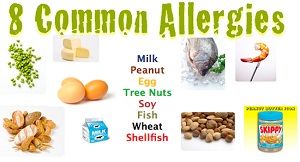Food allergies occur when the immune system reacts abnormally to certain foods. They are becoming increasingly
common in children, affecting their health and daily lives. This article aims to shed light on food allergies in
children, their common symptoms, causes, and possible preventive measures.
Common Food Allergens
Several foods are known to be common allergens in children. These include:
Peanuts
Milk
Eggs
Tree nuts (such as walnuts, almonds, and cashews)
Soy
Wheat
Fish
Shellfish
Symptoms of Food Allergies
Food allergies can cause a range of symptoms in children, including:
Hives or rash
Swelling of the lips, tongue, or face
Itching or tingling sensation in the mouth
Abdominal pain or cramps
Nausea and vomiting
Diarrhea
Difficulty breathing
Wheezing or coughing
Dizziness or lightheadedness
Causes of Food Allergies
The exact causes of food allergies in children are not yet fully understood. However, certain factors are believed to
contribute to their development:
Genetics: Children with a family history of allergies are at a higher risk of developing food allergies.
Delayed Introduction of Certain Foods: Introducing highly allergenic foods too early or too late during
infancy may increase the likelihood of developing food allergies.
Immune System Dysfunction: The immune system’s overreaction to certain proteins in food can trigger an allergic
response.
Environmental Factors: Exposure to environmental allergens and pollutants may increase the risk of food
allergies in children.
Diagnosis and Treatment
If you suspect your child has a food allergy, it is essential to consult a healthcare professional. They will assess
your child’s symptoms, medical history, and perform diagnostic tests, such as skin prick tests or blood tests, to
identify specific food allergens.
The primary treatment for food allergies in children is strict avoidance of the allergenic food. This involves
reading food labels carefully, preparing meals at home instead of relying on processed foods, and being cautious
when eating out.
In cases of severe allergic reactions, children may be prescribed epinephrine auto-injectors (e.g., EpiPen) to carry
at all times for immediate use in emergency situations.
Prevention Strategies
While it is impossible to prevent food allergies entirely, there are strategies parents can follow to reduce the risk
of their child developing allergies:
Exclusive breastfeeding for at least the first four to six months of life
Gradually introducing solid foods, including common allergens, between four and six months
Consulting with a healthcare professional before introducing allergenic foods
Regularly washing hands and utensils to minimize cross-contamination
Creating allergy-free zones at home, especially for highly allergic children
Educating caregivers, teachers, and other family members about the child’s allergies
Conclusion
Food allergies in children can have a significant impact on their health and quality of life. By understanding the
common allergens, symptoms, causes, and preventive measures, parents can navigate the challenges and help their
children live a safe and fulfilling life despite their food allergies. Regular communication with healthcare
professionals and being prepared for potential allergic reactions can make a world of difference.


